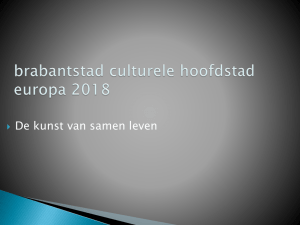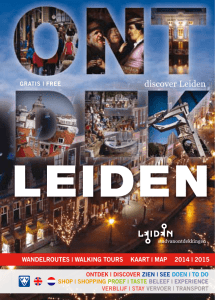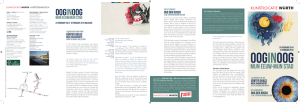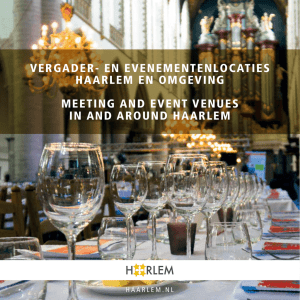Inkijk Exemplaar - Amsterdam by Night
advertisement
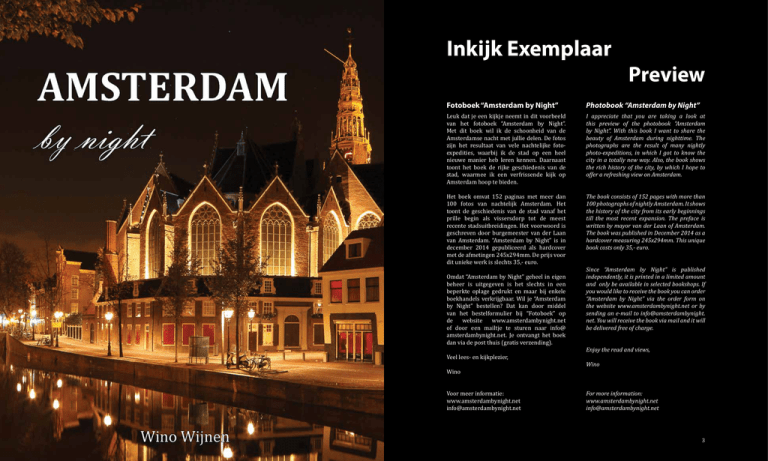
Inkijk Exemplaar Fotoboek “Amsterdam by Night” Photobook “Amsterdam by Night” Leuk dat je een kijkje neemt in dit voorbeeld van het fotoboek “Amsterdam by Night”. Met dit boek wil ik de schoonheid van de Amsterdamse nacht met jullie delen. De fotos zijn het resultaat van vele nachtelijke fotoexpedities, waarbij ik de stad op een heel nieuwe manier heb leren kennen. Daarnaast toont het boek de rijke geschiedenis van de stad, waarmee ik een verfrissende kijk op Amsterdam hoop te bieden. I appreciate that you are taking a look at this preview of the photobook “Amsterdam by Night”. With this book I want to share the beauty of Amsterdam during nighttime. The photographs are the result of many nightly photo-expeditions, in which I got to know the city in a totally new way. Also, the book shows the rich history of the city, by which I hope to offer a refreshing view on Amsterdam. Het boek omvat 152 paginas met meer dan 100 fotos van nachtelijk Amsterdam. Het toont de geschiedenis van de stad vanaf het prille begin als vissersdorp tot de meest recente stadsuitbreidingen. Het voorwoord is geschreven door burgemeester van der Laan van Amsterdam. “Amsterdam by Night” is in december 2014 gepubliceerd als hardcover met de afmetingen 245x294mm. De prijs voor dit unieke werk is slechts 35,- euro. Omdat “Amsterdam by Night” geheel in eigen beheer is uitgegeven is het slechts in een beperkte oplage gedrukt en maar bij enkele boekhandels verkrijgbaar. Wil je “Amsterdam by Night” bestellen? Dat kan door middel van het bestelformulier bij “Fotoboek” op de website www.amsterdambynight.net of door een mailtje te sturen naar info@ amsterdambynight.net. Je ontvangt het boek dan via de post thuis (gratis verzending). Veel lees- en kijkplezier, Wino Voor meer informatie: www.amsterdambynight.net info@amsterdambynight.net 2 Preview The book consists of 152 pages with more than 100 photographs of nightly Amsterdam. It shows the history of the city from its early beginnings till the most recent expansion. The preface is written by mayor van der Laan of Amsterdam. The book was published in December 2014 as a hardcover measuring 245x294mm. This unique book costs only 35,- euro. Since “Amsterdam by Night” is published independently, it is printed in a limited amount and only be available in selected bookshops. If you would like to receive the book you can order “Amsterdam by Night” via the order form on the website www.amsterdambynight.net or by sending an e-mail to info@amsterdambynight. net. You will receive the book via mail and it will be delivered free of charge. Enjoy the read and views, Wino For more information: www.amsterdambynight.net info@amsterdambynight.net 3 Inhoudsopgave Table of Contents Inhoudsopgave / Table of Contents2 Voorwoord / Preface 4 Introductie / Introduction5 Historie van Amsterdam / History of Amsterdam9 Joods Amsterdam / Jewish Amsterdam56 De VOC / The VOC58 De West-Indische Compagnie / The West-India Company 59 18de en 19de Eeuw / 18th and 19th Century 62 Einde van de Gouden Eeuw / End of the Golden Age 62 Buitenhuizen / Country Mansions67 Overzeese kolonien / Overseas Colonies70 Kritiek op het Kolonialisme / Criticism against Colonialism 74 9 De Middeleeuwse Stad / The Medieval Town F A / f e L o r P p k M Dru 10 Gevormd door Water en Wind / Shaped by Water and Wind 10 Het Stichten van een Wereldstad / Founding of a Metropolis 11 12 Stadsrechten / City Rights12 De Oude Binnenstad / The Old Center 13 Middeleeuwse Stadsomwalling / Medieval City Walls 14 De Oude Kerk / The Oude Kerk15 Kerken en Kloosters / Churches and Monasteries 19 De Nieuwe Kerk / The Nieuwe Kerk 19 Middeleeuwse Vestingswerken / Medieval Defenses 23 Late Middeleeuwen / Late Middle Ages24 Reformatie en Alteratie / Reformation and Alteration 28 Reformatie / Reformation28 Alteratie / Alteration28 Schuilkerken / Clandestine Churches31 e E v e X niti E fi e D K J I K De Gouden Eeuw / The Golden Age 32 Economische Groei / Economic Growth32 Zeehandel / Sea Trade34 De Grachtengordel / The Canal Belt35 Dichters en Schrijvers / Poets and Writers 38 Westerkerk / Westerkerk43 De Jordaan / The Jordaan44 De Binnenstad / The Inner City48 Rembrandt van Rijn / Rembrandt van Rijn 50 Spinoza / Spinoza51 N I Centrum van de Wereld / Center of the World 52 Groeiende Stad / Growing City52 Stadhuis / City Hall52 Technologische Ontwikkelingen / Technological Breakthroughs 55 4 V E 76 Industrialisatie / Industrialization76 Stadsverlichting en Gasfabrieken / City Lighting and Gas Factories 77 Centraal Station / Central Station82 NDSM / NDSM83 Gehuld in Duisternis / Shrouded in Darkness Het Prille Begin / The Very Beginning W IE Industriele Revolutie / Industrial Revolution R P / oof Hernieuwde Groei / Renewed Growth 86 De Opbloeiende Stad / The Flourishing City 86 Vondelpark / Vondelpark90 Sint Nicolaasbasiliek / Saint Nicholas Basilica 94 Concertgebouw en Rijksmuseum / Concert Hall and Rijksmuseum 95 Expansie en Annexaties / Expansion and Annexations 98 Berlage en de Amsterdamse School / Berlage and the Amsterdam School 104 Sport en Recreatie / Sport and Recreation 106 Olympische Spelen / Olympic Games107 De Oorlogsjaren / The War Years110 r R P A inal De Moderne Stad / The Contemporary City 112 Na-oorlogse Opbouw / Post-war Reconstruction112 Immigratie / Immigration114 De Jaren Zestig / The Sixties116 Grootschalige Nieuwbouw / Large-scale Development 120 Kunstzinnig Amsterdam / Artistic Amsterdam126 Anonieme Kunst / Anonymous Art127 Moderne Architectuur / Modern Architecture130 De Zuidas / The Zuidas132 Zuid-Oost / Zuid-Oost133 Oost / East136 Moderne Verbindingen / Modern Connections140 Op Weg naar de Toekomst / Towards the Future 141 Nawoord / Epilogue 146 Bronvermelding / References Dankwoord / Acknowledgements Donateurs / Sponsors Foto-index / Photo-index 147 148 149 150 Informatie & Colofon / Information & Credits152 5 Voorwoord Introductie Preface ‘Show, don’t tell‘ is an important proverb when telling stories. For example, you do not always say that Amsterdam is very beautiful, you describe it. This photobook takes that proverb quite literally, the elegance of our city is beautifully portrayed. At the same time one can appreciate that Amsterdam has a rich history. ‘Show, don’t tell’ is een belangrijk adagium bij het vertellen van verhalen. Je zegt bijvoorbeeld niet steeds dat Amsterdam heel mooi is, dat omschrijf je. Dit fotoboek neemt dat adagium heel letterlijk, de uiterlijke schoonheid van onze stad is prachtig in beeld gebracht. Zo is te zien dat Amsterdam een rijke historie kent. This book shows a portrait of present-day Amsterdam and places the modern city in a historical perspective. On the basis of the pictures, the reader is taken on a journey of exploration through the nightly city, where both known and lesser known areas of Amsterdam are presented. The book tells the story of a fishing village that grew to become a world power. Also the darker periods in the Amsterdam history are not neglected. Dit boek toont een portret van het hedendaagse Amsterdam en plaatst de moderne stad in een historisch perspectief. Aan de hand van de foto’s wordt de lezer meegenomen op een ontdekkingstocht door de nachtelijke stad, waarbij zowel bekende als minder bekende stukjes Amsterdam de revue passeren. Het boek vertelt het verhaal van een vissersdorpje dat uitgroeide tot een wereldmacht. Ook de duistere periodes uit de Amsterdamse geschiedenis worden niet geschuwd. Hoewel het boek een persoonlijke verkenning van de stad is komt vrijwel de gehele geschiedenis voorbij. Daarmee biedt “Amsterdam by Night” een nadere kennismaking met de stad, zowel voor nieuwkomers als rasechte Amsterdammers. N I Graag maak ik fotograaf Wino Wijnen een compliment voor de wijze waarop hij nachtelijk Amsterdam in beelden heeft gevat. Ik hoop dat veel lezers plezier zullen beleven aan dit boek. Mr. E.E. van der Laan Burgemeester van Amsterdam 4 e E v e X niti Through the dark skies over the city, the featured buildings show another face, an unfamiliar view of the city that you do not usually appreciate during daytime. In addition, the photos hardly show any people. That is a particular scene in a metropolis. Also in this regard, the pictures offer a different look at Amsterdam. I would like to make photographer Wino Wijnen a compliment for the way he has captured nightly Amsterdam in pictures. I hope that many readers will enjoy this book. Mr. E.E. van der Laan Goede Nacht! W IE Goodnight! V E De nacht is niet het meest voor de hand liggende thema voor een fotoboek. Helaas nemen we niet altijd de tijd om te genieten van de nacht. Het is donker, leeg en koud, en we gaan er gehaast aan voorbij of liggen we te slapen. R P / oof The night is not one of the most obvious subjects for a photobook. Unfortunately we do not always take the time to enjoy the night. It is dark, empty and cold, and we normally pass through quickly or have a good night’s rest in bed. De duisternis herbergt echter een schoonheid die alleen aan de oplettende kijker wordt prijs gegeven. In het donker van de nacht ligt een overweldigende kleurenpracht verborgen. Met “Amsterdam by Night” wil ik een beetje van deze schoonheid met jullie delen. The darkness harbors however a beauty that is only revealed to the keen observer. An overwhelming range of intense colors is hidden in the dark of the night. With “Amsterdam by Night” I hope to be able to share a bith of this beauty with you. Tegenwoordig is Amsterdam een relatief kleine stad, maar wel eentje met een rijke historie. Tijd voor een nadere kennismaking met de duistere kant van Amsterdam. Nowadys, Amsterdam is a relatively small city, but certainly one with a rich history. It time for a close encounter with the dark side of Amsterdam. r R P A inal F A / f e L o r P p k M Dru Although the book is a personal exploration of the city, it covers almost the whole history of Amsterdam. Thereby “Amsterdam by Night” offers a further acquaintance with the city, both for newcomers as well as the full-blooded Amsterdammers. E fi e D K J I K Door de donkere lucht over de stad krijgen uitgelichte gebouwen een ander gezicht, een uiterlijk dat je in de stad niet gewend bent te zien overdag. Bovendien zijn op de foto’s amper mensen te zien. Dat is in een wereldstad een bijzonder tafereel. Ook op die manier geven de foto’s een andere blik op Amsterdam. Introduction Aan de hand van de fotos van nachtelijk Amsterdam heb ik getracht een hedendaags beeld van de stad te schetsen, maar dit ook in een historisch perspectief te plaatsen. De fotos nemen ons mee op een reis van het prille begin, via de Gouden Eeuw, naar de huidige moderne stad. We zien hoe Amsterdam door de eeuwen heen uitgroeide van een vissersdorpje tot een handelscentrum en een 17de eeuwse wereldstad. Through the photographs of nightly Amsterdam I have tried to provide a contemporary view of the city, while simultaneously placing it in a broader historic perspective. The photos take us on a journey of discovery from the early beginning, via the Golden Age, to the present modern city. We see how Amsterdam developed during the centuries, from a small fishing village to a trade center and a 17th century world power. Veel lees- en kijkplezier met “Amsterdam by Night”! Enjoy the read and views of “Amsterdam by Night”! Wino Wino November 2014 November 2014 Mayor of Amsterdam 5 N I 8 e E v e X niti E fi e D K J I K F A / f e L o r P p k M Dru V E R P / oof r R P A inal W IE 9 Historie van Amsterdam History of Amsterdam De geschiedenis van Amsterdam gaat terug tot om en nabij de 12de eeuw. Het is daarmee een relatief jonge stad, zeker in vergelijking met andere Europese hoofdsteden zoals Rome, Athene of Parijs. Ook voor Nederlandse begrippen behoort Amsterdam tot de nieuwkomers: omliggende steden als Haarlem, Utrecht, Tiel en Delft zijn eerder gesticht. Steden als Maastricht en Nijmegen floreerden zelfs al tijdens de Romeinse tijd terwijl destijds in de omgeving van het latere Amsterdam nog vrij weinig te beleven was. De vroege historie van Amsterdam is daarmee gehuld in diepe duisternis, maar op basis van oude documenten en opgravingen kan er toch een beeld gevormd worden over het ontstaan van de stad. R P / oof r R P A inal N I is waarschijnlijk afgeleid van het familiewapen van Jan Persijn, een vroege heerser van Amsterdam. Het oudste document met dit wapen dateert uit 1419. The coat of arms of Amsterdam. The coat of arms is probably derived from the one of Jan Persijn, an early lord of Amsterdam. The oldest document that bears this symbol dates to 1419. e E v e X niti E fi e D K J I K Het stadswapen van Amsterdam. Het wapen F A / f e L o r P p k M Dru W IE V E Gehuld in Duisternis Shrouded in Darkness The history of Amsterdam goes back till somewhere around the 12th century. Amsterdam is thereby a relatively young city, certainly when compared with other European capitals like Rome, Athens or Paris. Also for Dutch standards Amsterdam belongs to the newcomers: nearby cities like Haarlem, Utrecht, Tiel and Delft were all founded before Amsterdam. The Dutch cities of Maastricht and Nijmegen were already flourishing during Roman times, while very little of notice was going on in the lands that would eventually give rise to Amsterdam. The early history of Amsterdam is therefore shrouded in darkness, but with the help of old documents and archeological excavations it is possible to form an impression about the origins of Amsterdam. Sterrenhemel boven het Vondelpark. Zelfs in het donker van de nacht zijn er altijd lichtpuntjes te zien. Starry sky above Vondelpark. Even in the darkness of the night there are always some bright spots. 10 11 Het Prille Begin Het Stichten van een Wereldstad The Very Beginning Gevormd door Water en Wind Uitzicht over de Amstel. Tegenwoordig is er weinig over van het woeste landschap waar Amsterdam haar oorsprong in vond. View over the Amstel. These days little remains of the wild landscapes in which Amsterdam found its origins. Shaped by Water and Wind Before the 12th century the region of presentday Amsterdam was a desolate marshland, exposed to the elements and tides of the Zuiderzee. Slowly, these lands became inhabited by fishermen and farmers in search of new opportunities to make a living. The steadily increasing population felt the need to control the waters, and after two successive floods in 1170 and 1173 it was decided to erect dikes along the coast of the Zuiderzee (currently the IJselmeer and IJ). A bridge and dam were constructed at the estuary of the Amstel in the IJ and a small village developed along the river. It was called Aemstelredamme, and would eventually become known as Amsterdam. Voor de 12de eeuw was het gebied van het huidige Amsterdam een ongerept moerasland dat bloot stond aan de elementen en getijden van de Zuiderzee. Langzaam werd het gebied bevolkt door vissers en boeren op zoek naar nieuwe kansen. Met de gestaag toenemende bevolking kwam de noodzaak om het water te bedwingen, en na twee zware overstromingen in 1170 en 1173 werd besloten tot de aanleg van dijken langs de Zuiderzee (het huidige IJselmeer en IJ). Op de locatie waar de Amstel uitmondt in het IJ werden een brug en een dam gebouwd. Aan de rivier ontstond een kleine nederzetting met de naam Aemstelredamme, die later bekend zou worden als Amsterdam. N I F A / f e L o r P p k M Dru Little is known about the early history of Aemstelredamme, and even less remains visible. Certainly the settlement steadily developed from a fishing village to a regional trade center. Its convenient location along the Zuiderzee, combined with its good connection with the hinterlands made Aemstelredamme a perfect home port for trade ships. The trading spirit of the early inhabitants is evident from the first official mentioning of the town in written history: in a document dating from 1275, count Floris V granted the citizens of Amestelledamme freedom of taxation at bridges, locks and dams in the whole of Holland. During this period, Amsterdam probably counted no more than a couple of hundred inhabitants. The settlement stretched along the Amstel. The Damrak at the IJ-side of the dam became the harbor of Amsterdam. The waters at the other side of the dam became the Rokin. Traces of an early dam have been found at the beginning of the 20th century underneath Dam square, between the National Monument and Bijenkorf. W IE V E R P / oof r R P A inal Founding of a Metropolis e E v e X niti E fi e D K J I K Over de vroege historie van Aemstelredamme is weinig bekend, en nog minder tastbaars overgebleven. Zeker is dat de nederzetting gestaag uitgroeide van vissersdorpje tot regionaal handelscentrum. De gunstige ligging aan de Zuiderzee en de goede verbinding met het achterland maakten Aemstelredamme tot een uitstekende thuishaven voor handelsschepen. De handelsdrift van de vroege Amsterdammers blijkt uit de eerste officiele vermelding van Amsterdam in de geschriften: in een bewaard gebleven document uit 1275 gaf graaf Floris V de bewoners van Amestelledamme vrijstelling van tol bij alle bruggen, sluizen en dammen in Holland. In deze periode telde Amsterdam hooguit een paar honderd inwoners. De bebouwing strekte zich uit langs de Amstel. Aan de IJ-zijde van de dam lag de Amsterdamse haven aan het Damrak. Het water aan de andere zijde van de dam werd het Rokin. Aan het begin van de 20ste eeuw zijn sporen van een dam gevonden onder de Dam, tussen het Nationaal Monument en de Bijenkorf. Kaart van Nederland omstreeks 1609. De lo- catie van Amsterdam aan de Zuiderzee maakten de stad tot een uitstekende uitvalsbasis voor schippers en handelaren. Map of the Netherlands from about 1609. The lo- cation of Amsterdam along the Zuiderzee made the city an excellent home for sailors and traders. 12 13 De Middeleeuwse Stad The Medieval Town Stadsrechten Koffieschenkerij bij de Oude Kerk. Een van die plekjes in Amsterdam waar je je nog in de middeleeuwse stad kunt wanen. Koffieschenkerij at the Oude Kerk. One of those places in Amsterdam where you can still feel like being in a medieval town. Amsterdam received its city rights around 1300. This provided the city with the privileges of taxation and jurisdiction, the right to collect toll. The city was also allowed to hold markets and build city walls. With these city rights, Amsterdam gained more independence from the counts of Holland and the religious authorities. This independence, and the lack of a traditional aristocracy, stood at the basis of the rapid development of Amsterdam into a regional trade center. Omstreeks 1300 ontving Amsterdam stadsrechten, waarmee de stad privileges verwierf als belastingheffing en rechtspraak, het heffen van tol, het houden van markten en het bouwen van stadsmuren. Met deze stadsrechten verwierf Amsterdam meer onafhankelijkheid van zowel de heersers van Holland als het kerkelijk gezag. Deze onafhankelijkheid, en de afwezigheid van een gevestigde aristocratie, droegen bij aan de snelle ontwikkeling van Amsterdam als handelsstad. N I 14 F A / f e L o r P p k M Dru e E v e X niti E fi e D K J I K R P / oof r R P A inal W IE V E City Rights Houten huis aan de Zeedijk. Cafe “In ‘t Aepjen” (+/- 1548) is een van de twee overgebleven huizen met een originele houten voorgevel. Wooden house at the Zeedijk. Cafe “In ‘t Aepjen” (+/- 1548) is one of the two remaining houses with an original wooden facade. De Oude Binnenstad De haven aan het Damrak ontwikkelde zich verder en tussen 1300 en 1400 nam de bevolking toe van enkele honderden tot een kleine 3000 inwoners. De stad groeide aan weerszijden van de Amstel langs de huidige Warmoesstraat en Nieuwendijk. Het deel ten oosten van de Amstel stond bekend als de oude zijde, terwijl de westkant de nieuwe zijde genoemd werd. De tegenwoordige Zeedijk vormde in die periode daadwerkelijk een dijk die de stad beschermde tegen de Zuiderzee. The Old Center The harbor at Damrak developed further and the population increased between 1300 and 1400 from several hundreds to about 3000 inhabitants. The city grew on both sides of the Amstel, mainly along the Warmoesstraat and Nieuwendijk. The part to the east of the Amstel would become known as the oude zijde (old side), while the west was called nieuwe zijde (new side). During this period, the Zeedijk was a real dike that protected the city against the Zuiderzee. 15 Middeleeuwse Stadsomwalling Medieval City Walls As a consequence of receiving its city rights, Amsterdam was allowed to construct city walls. At 1340, a moat and earthen defensive wall was built around the city. The moat can still be seen next to the Oude Kerk (the canal of Oudezijds Voorburgwal). The first defensive walls quickly became too small for the fast growing city, whereupon a new wall was constructed in Als gevolg van de verkregen stadsrechten mocht Amsterdam een stadsmuur bouwen. Rond 1340 werden een gracht en aarden verdedigingswal aangelegd. Deze gracht is nog te zien nabij de Oude Kerk (de gracht van Oudezijds Voorburgwal). De eerste omwalling was al snel te klein voor de hard groeiende stad, waarna omstreeks 1385 een nieuwe V E R A in N I De Schreierstoren. Deze verdedigingstoren was onderdeel van de middeleeuwse stadsmuren. Hij werd rond 1487 gebouwd ter bescherming van de oostelijke stad en de haven. The Schreierstoren. This defensive tower was part of the medieval city walls. It was built in about 1487 to protect the eastern part of the city and the harbor. 16 e E v e X niti E fi e D K J I K F A / f e L o r P p k M Dru W IE R P / oof Kaart van Amsterdam omstreeks 1538. De kaart toont de stad ten tijde van de derde omwalling. Het Damrak en Rokin liggen centraal, met links de Oude Kerk en rechts de Nieuwe Kerk. Links onder aan de haven staat de Schreierstoren. De Montelbaanstoren is iets verder naar links te zien. Map of Amsterdam at about 1538. The map r P al stadswal werd aangelegd. Hoewel weinig is overgebleven van deze beide originele stadswallen hebben ze wel hun stempel op de stad gedrukt: de straten en grachten die de verdedigingswerken volgden heten nog steeds Oude- en Nieuwezijds Voor- en Achterburgwal. Ook de naam van de rosse buurt “De Wallen” is afgeleid van de middeleeuwse stadsomwalling die de stad beschermde. De Oude Kerk Rond 1306 werd ten oosten van de Warmoesstraat de Oude Kerk gebouwd en gewijd aan Sint Nicolaas, beschermheilige van zeelieden en handelaren. Deze kerk, die in eerste instantie Sint Nicolaaskerk heette, is het oudste nog bestaande gebouw van Amsterdam. Door de bouw van de Oude Kerk werd Amsterdam in kerkelijk opzicht onafhankelijk: tot 1334 behoorden de inwoners namelijk tot de parochie van Amestelle, het hedendaagse Ouderkerk aan de Amstel. In 1369 werd het originele kleine kerkje al verbouwd tot een grotere gotische kerk. Het huidige imposante gebouw is het resultaat van meerdere uitbreidingen. shows the city with its third city walls. The Damrak and Rokin in the center are flanked by the Oude Kerk to the left and the Nieuwe Kerk to the right. At the bottom left we find the Schreierstoren in the harbor. The Montelbaanstoren is shown further to the left. 1385. Although little remains of the original city walls, they did leave a lasting impression on Amsterdam: the streets and canals along the defensive works are known as the Oude- and Nieuwezijds Voor- and Achterburgwal (wal is the Dutch word for wall). Also the red light district is better known by its name “De Wallen”, in reference to the medieval city walls that used to protect the city. The Oude Kerk In 1306, the Oude Kerk was built to the east of Warmoesstraat. The church was dedicated to Saint-Nicholas, the patron of sailors and merchants. This church, initially called SaintNicholas church, is the oldest building in existence in Amsterdam. With the construction of the Oude Kerk, Amsterdam became clerically more independent: until 1334 the inhabitants belonged to the parish of Amestelle, the current Ouderkerk aan de Amstel. The little original church was already extended into a larger gothic church in 1369. The imposing building that we find nowadays is the result of several subsequent extensions. 17 De Oude Kerk (volgende paginas). Als oudste nog bestaande gebouw in de stad staat de Oude Kerk uit 1306 symbool voor het middeleeuwse Amsterdam. Op de voorgrond de Oudezijds Voorburgwal, een overblijfsel van de eerste stadsgracht. The Oude Kerk (next pages). As the oldest existing building of the city, the Oude Kerk from 1306 symbolizes medieval Amsterdam. In the front one can see the Oudezijds Voorburgwal, a remnant of the first city moat. N I 18 e E v e X niti E fi e D K J I K F A / f e L o r P p k M Dru V E R P / oof r R P A inal W IE 19
